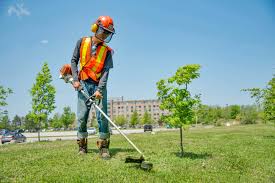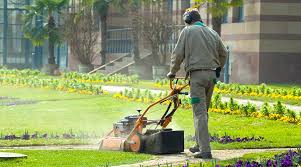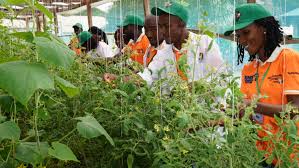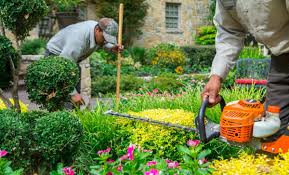After the pavers have been placed and the last shrub has been planted, the new landscape becomes vibrant. Although the yard may be transformed in a matter of days, the months and years that follow are what truly matter.
The care of a newly installed landscape is critical to the long-term growth and development of the plant materials and the integrity of the hardscape. Landscapes require an investment of both time and money.
They may be maintained by landowners or through the contracted services of a professional landscape company.
Essential Landscape Maintenance Tasks in Agricultural Environments
For plants to properly mature and thrive, several essential maintenance tasks should be frequently considered, such as watering, fertilizing, pruning, edging, and mulching.
1. Watering of Landscape Plants
Watering freshly planted trees, shrubs, and flowers is important to the longevity of the landscape. The first 1–2 weeks are the most critical for new plants as the roots still need to be established in the soil.
Even if plants are close to a water source, they are only able to absorb water near their small roots. Direct watering at a low pressure allows the plant to uptake the maximum amount of water.
Watering needs vary depending on the type of plant, size of the plant, and weather conditions. Checking the soil condition before watering helps prevent flooding the roots. If the soil is dry 4–7 inches deep, it is a sign that the plants need watering.
Good irrigation practices include the following:
- Watch for moisture stress symptoms before deciding when to irrigate. An abnormal gray-green color or obvious wilting are good indicators that a plant needs moisture.
- The best time to irrigate is at night or early in the morning to conserve moisture and reduce evaporative loss.
- Apply enough water to wet the soil to a depth of 8 to 10 inches to promote deep root growth. Avoid light, frequent irrigation that encourages shallow rooting.
Fertilization Techniques for Landscape Plant Health
Proper nutrition ensures optimum plant growth and resistance to diseases, insects, and environmental stress. Plants receiving proper nutrition also become more water efficient, with healthier, larger root systems that can better sustain the plant during limited rainfall.
Important fertilization considerations include:
- A soil test provides the best guide for determining fertilization requirements. A healthy landscape is more water efficient.
- Slow-release fertilizers ensure an even uptake of nutrients and a uniform growth rate. Excess nitrogen or high nitrate fertilizers cause rapid growth and an increased demand for water.
- Avoid over-fertilization, as excessive fertilizer can harm the plant’s water efficiency, health, and the surrounding environment.
- The frequency of fertilization depends on the plant type, age, and fertilizer used. Most established woody ornamentals need only one slow-release fertilizer application per year.
- Annuals benefit from light monthly applications of water-soluble fertilizer or a slow-release type.
- Newly planted ornamental trees and shrubs benefit from light fertilizer applications three times during the growing season.
- Fertilizer should be avoided during periods of limited rainfall or high temperatures.
Read Also: How to Grow, Use and Care for Yellow Indiangrass (Sorghastrum nutans)
Pruning Practices for Healthy Landscape Growth

If irrigation is not possible, cutting back herbaceous annuals and perennials that are wilting helps reduce water loss from leaves and reduces stress on the root system. Less water will then be lost through the leaves. Mulching helps with moisture retention in the soil.
Pruning also protects plants from damage and helps maintain an orderly landscape. Always trim branches at the base or collar of the branch to avoid disease vulnerability.
Key pruning practices include:
- During drought, reduce moisture loss by cutting back annual and perennial flowers.
- Maintain pruning tools in good condition to ensure clean cuts. Frayed cuts heal slowly and can increase water loss and susceptibility to disease.
- Use sharp tools, and keep them clean and oiled.
- Do not prune the natural form of feathered trees unless damaged, diseased, or dead wood is present.
- Prune according to good horticultural practices.
- Shape plants based on species, location, season, and growth stage, aiming for a well-balanced natural appearance.
- Trim off ragged bark edges with a sharp knife and make clean cuts to sound wood.
- Make cuts above and away from a healthy outward-facing bud to prevent water collection.
Benefits of pruning include:
- Maintaining or reducing plant size.
- Removing unwanted, weakened, diseased, or broken branches.
- Stimulating flower and fruit development.
- Revitalizing older plants.
- Preventing property damage.
Weed Control in Landscaped Areas

To ensure effective weed control:
- Use a suitable herbicide to maintain a weed-free zone around each tree base. Herbicide must be applied following manufacturer instructions, ensuring minimal spray drift.
- Keep the base of tree and shrub guards/shelters clear of weeds and grass through hand weeding.
- Remove all weeds by hand using hoes, trowels, or forks, while causing minimal soil disturbance and leaving a neat area.
- Apply herbicide carefully to grassed areas to avoid affecting existing grass or planted species.
- Spot application methods should be used to prevent herbicide drift onto desirable vegetation.
Inspection and Maintenance of Tree Stakes and Ties
Perform the following checks regularly:
- Inspect stakes for looseness, breaks, or decay; replace when needed.
- Remove stakes once the tree becomes self-supporting and fill holes with compacted soil.
- Adjust or replace defective ties and remove unnecessary labels, tapes, or tags.
- Ensure all guards around trees and shrubs are securely fastened.
Cleaning Out Dead Wood and Debris
For plant health and aesthetics:
- Remove all dead, dying, or diseased wood and stubs.
- Remove fungal growths and fruiting bodies.
- Remove accumulated debris or rubbish from branch forks.
Read Also: How to Grow, Use and Care for Yellow Indiangrass (Sorghastrum nutans)
Replacement Planting in Landscape Systems

For proper replacement planting:
- Use trees of the same species and similar size where practical.
- Apply sufficient water and fertilizer to help new trees establish.
- Avoid planting replacements during drought periods or outside the growing season.
Edging Techniques to Define Landscape Spaces
The edge of a landscape defines the space between distinct areas, often between a garden bed and a lawn. Edging materials such as plastic, metal, or bricks are used to form this boundary. In large areas, motorized edging machines are used to carve out defined edges.
Frequent edging during the active growing season maintains neatness. Edging can also be done manually with a shovel or hand tool (edger) that removes unwanted turfgrass or weeds and crumbles the clods back into the soil. A trimmer is often used by landscapers to maintain crisp edges.
Mulching for Moisture Retention and Soil Health
Mulching is essential for healthy landscape plants and offers several benefits:
- Retains soil moisture.
- Improves soil structure when organic mulch is used.
- Prevents soil crusting and compaction.
- Enhances the landscape’s aesthetic value.
- Reduces weed growth.
- Regulates soil temperature, keeping it cooler in summer and warmer in winter.
- Minimizes soil splashing, reducing the spread of soil-borne diseases.
- Limits soil erosion.
Do you have any questions, suggestions, or contributions? If so, please feel free to use the comment box below to share your thoughts. We also encourage you to kindly share this information with others who might benefit from it. Since we can’t reach everyone at once, we truly appreciate your help in spreading the word. Thank you so much for your support and for sharing!

